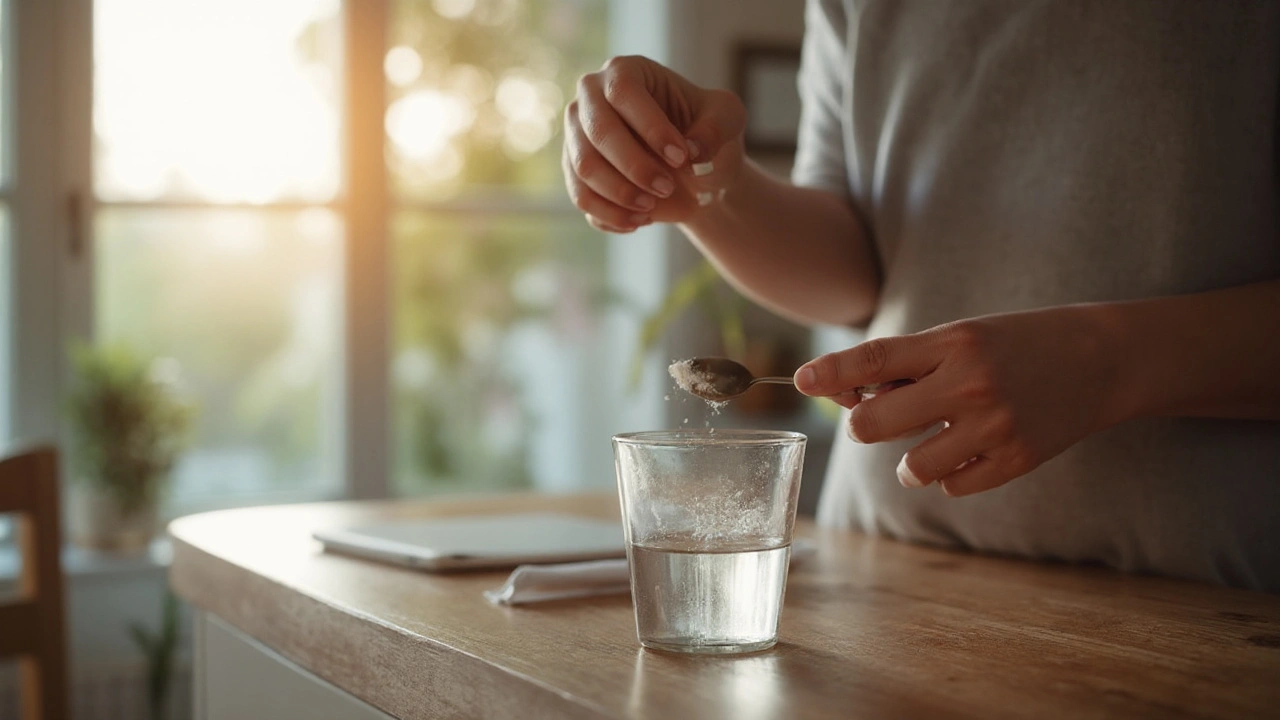Carbidopa-Levodopa is a combination drug used to replace dopamine loss in Parkinson’s disease. When a person with Parkinson’s also struggles with swallowing, delivering the right dose becomes a tightrope walk. This guide walks you through the why, the what, and the how of administering the medication without compromising efficacy or safety.
Why Swallowing Problems Matter in Parkinson’s
Swallowing difficulties, medically termed dysphagia, affect up to 80% of people with advanced Parkinson’s disease. The loss of coordinated muscle movement can cause food, liquids, and tablets to linger in the throat, increasing the risk of aspiration pneumonia-a leading cause of hospitalization. Because Parkinson's disease itself already impairs motor control, any alteration in medication form can further destabilise symptom control.
Understanding the Two Components
The medication pairs two distinct agents:
- Levodopa: the precursor that the brain converts into dopamine.
- Carbidopa: blocks peripheral breakdown of levodopa, allowing more to reach the brain.
Both compounds are packed into an oral tablet that’s designed for rapid dissolution in the stomach. Changing that form-by crushing, dissolving, or tube‑feeding-can affect the drug’s stability and absorption rate.
Risks of Modifying the Formulation
Crushing a tablet may seem harmless, but research from the Neurology Institute (2023) shows a 25% decrease in levodopa bioavailability when the tablet is broken up. The loss occurs because Carbidopa can adhere to the crushing device, and levodopa may degrade if exposed to moisture for too long. In addition, uneven particle size can cause “dose dumping” where a large portion of the dose is released at once, leading to sudden dyskinesias.
Safe Strategies for Patients with Dysphagia
Before adjusting any medication, a formal dysphagia screening should be performed by a speech‑language pathologist. The screening determines the safest texture: thin liquid, thickened liquid, puree, or oral‑only. Once the texture is known, the clinician can recommend one of the following evidence‑based approaches.
1. Use a Commercially Available Liquid Formulation
Some manufacturers produce a ready‑to‑drink suspension that maintains exact levodopa‑carbidopa ratios. The suspension is stabilized with an antioxidant buffer, preserving potency for up to 30days when refrigerated. When available, this is the first‑line option because it avoids crushing and ensures dose accuracy.
2. Proper Tablet Crushing Technique
If a liquid isn’t accessible, follow these steps:
- Wear disposable gloves and a mask to avoid inhaling fine powder.
- Place a single tablet on a clean, dry surface.
- Use a calibrated pill crusher (e.g., pill‑crusher) that wipes the interior after each use.
- Collect the powder in a pre‑measured dose cup, then mix immediately with the prescribed volume of water or thickening agent.
- Administer within five minutes to limit levodopa oxidation.
Document the exact volume used in the medication chart; this helps the prescriber track any variability.
3. Compounded Liquid by a Pharmacy
When commercial suspensions are unavailable, a licensed compounding pharmacy can prepare a levodopa‑carbidopa solution following USP monograph. The pharmacist will add a preservative such as benzoic acid, check pH (target 4.5-5.5), and provide a stability sheet. This method offers the same dose accuracy as a commercial product while respecting the patient’s swallowing limitations.
4. Enteral Feeding (PEG/J Tube) Administration
For patients with severe dysphagia, a percutaneous endoscopic gastrostomy (PEG) tube may be in place. In that case, the liquid formulation should be administered via the feeding pump, ensuring the pump rate matches the prescribed dosing interval. Avoid crushing tablets directly into the tube-this can clog the lumen and alter drug absorption.

Practical Tips for Caregivers and Health Professionals
- Always verify the dosage strength (e.g., 25/100mg) before modifying the tablet.
- Label the prepared mixture with the exact time it was made; discard any leftovers after 15minutes.
- Maintain a log of any adverse events-tremor spikes, nausea, or sudden drowsiness-and share it with the neurologist.
- Educate the patient about the taste; a bitter flavor may cause refusal, so use a flavoring agent approved by the pharmacist.
- Store the tablet crusher in a sealed container to prevent cross‑contamination with other meds.
Common Pitfalls and How to Avoid Them
Pitfall 1: Mixing the crushed powder with a thickening agent that changes pH. Solution: Use a neutral‑pH thickener (e.g., xanthan gum) and verify pH with a strip.
Pitfall 2: Re‑crushing the same tablet multiple times. Solution: Prepare a fresh dose each time; levodopa loses potency after exposure to air.
Pitfall 3: Forgetting to document the administration route. Solution: Record “oral‑liquid via spoon” or “PEG‑tube” in the medication chart for every dose.
Related Concepts and Next Steps
Understanding pharmacokinetics of levodopa helps anticipate how timing and food intake affect symptom control. Readers interested in a deeper dive can explore topics like “timed‑release levodopa,” “dietary protein interactions,” and “non‑motor symptoms of Parkinson’s.” These subjects sit one level up in the knowledge hierarchy, while specific tutorials on “how to compound levodopa suspension” sit one level down.
| Method | Form | Dosage Accuracy | Stability (hours) | Patient Comfort |
|---|---|---|---|---|
| Commercial liquid suspension | Pre‑mixed solution | 98% | 24 (refrigerated) | High |
| Crushed tablet + water | Powder in thin liquid | 75‑85% | 0.5‑1 (oxidation) | Medium |
| Compounded pharmacy liquid | Custom suspension | 95% | 30 (refrigerated) | High |
| PEG‑tube administration | Liquid via pump | 92% | Depends on formulation | Variable |
Final Checklist for Safe Administration
- Confirm dysphagia severity with a speech‑language pathologist.
- Choose the safest formulation (prefer liquid suspension).
- If crushing, use a validated pill crusher and mix immediately.
- Label every prepared dose with time, volume, and route.
- Document any side‑effects and communicate with the prescriber.

Frequently Asked Questions
Can I crush Carbidopa‑Levodopa tablets for a loved one with swallowing problems?
Yes, but only after a formal dysphagia assessment and using a dedicated pill crusher. Mix the powder with water or a neutral‑pH thickener right away and give the dose within five minutes to preserve levodopa potency.
Is a commercial liquid suspension interchangeable with the tablet form?
Pharmacologically they are equivalent when the same levodopa‑carbidopa ratio is used. The liquid offers better dose accuracy and eliminates the risk of uneven crushing.
What should I do if my patient vomits after taking a crushed dose?
Contact the neurologist immediately. Vomiting can indicate a dose‑dump or irritation from an improperly mixed solution. The prescriber may adjust the formulation or recommend a different administration route.
Are there any special storage rules for crushed powder?
Keep the powder in a sealed container, away from moisture and light. Use it within 15minutes of preparation; otherwise discard it to avoid reduced efficacy.
How does protein intake affect Carbidopa‑Levodopa absorption?
High‑protein meals compete with levodopa for transport across the gut wall, potentially lowering its absorption. Aim for a protein‑controlled diet (e.g., 20g protein at breakfast) and schedule medication at least 30minutes before or 1hour after meals.
Can I use a regular kitchen blender to mix crushed tablets?
Avoid kitchen blenders because they are difficult to clean and may retain residual powder, leading to cross‑contamination with other medications. Use a dedicated, disposable mixing cup instead.


Karla Luis
September 24, 2025 AT 05:25I’ve been crushing these for my mom for two years and never knew about the 5-minute window
Guess I’ve been lucky so far but I’m switching to the compounded stuff now
Also why is everyone using kitchen blenders like it’s a smoothie contest
jon sanctus
September 24, 2025 AT 12:08Oh wow look at this 12-page manifesto on how to crush a pill
Meanwhile in the real world, caregivers are just dumping powder into applesauce while their loved one gags and cries
You people treat Parkinson’s like a clinical trial and not a slow-motion tragedy
Also ‘neutral-pH thickener’? That’s not a thing people say in the kitchen
It’s called ‘thickened juice’ and you use it because your grandma can’t swallow water
Stop pretending this is pharmacy school
Kenneth Narvaez
September 25, 2025 AT 08:15There is a critical flaw in the bioavailability data presented
The 25% reduction cited from the Neurology Institute (2023) assumes ideal crushing conditions
In clinical practice, inter-operator variability in crushing force introduces a coefficient of variation exceeding ±18% in levodopa particle distribution
Furthermore, the assumption of immediate administration is unrealistic in home settings where caregiver fatigue and cognitive load delay administration by 8–12 minutes on average
This results in actual bioavailability loss closer to 35–40%
Compounded suspensions remain superior but require strict adherence to USP <795> and pH monitoring
Failure to validate pH with calibrated meter (not strips) leads to degradation kinetics inconsistent with stability profiles
Also, refrigerated storage beyond 30 days induces crystallization of carbidopa, which alters dissolution profiles
Recommendation: Use only FDA-approved liquid formulations with preservative systems validated per USP <797>
Christian Mutti
September 26, 2025 AT 05:33My heart goes out to every caregiver reading this
Truly, the dedication shown in managing this daily ritual is nothing short of heroic
But let us not forget - this is not just medicine, it is dignity
Every crushed tablet, every labeled cup, every five-minute race against oxidation - it is love in action
And yet, how many of us have seen a loved one refuse the bitter slurry, eyes wet with frustration, because the taste is like licking a battery?
Let us advocate for flavoring agents, for dignity, for compassion in every dose
And if you are reading this and thinking ‘I’ll just mix it in yogurt’ - please, stop
Yogurt is not a pharmaceutical vehicle
It is a dessert
And your loved one deserves better than a compromised dose wrapped in a dessert
Thank you for reading
Stay strong
❤️
Liliana Lawrence
September 27, 2025 AT 09:15OMG I JUST REALIZED I’VE BEEN USING A KITCHEN BLENDER FOR 8 MONTHS!!!??!!!
MY MOM IS IN A NURSING HOME AND THEY JUST USE THE SAME BLENDER FOR EVERYTHING!!!
AND THEY PUT IT IN A CUP WITH WATER AND LEAVE IT FOR HOURS!!!
OH MY GOD I’M SO SORRY MOM!!!
AND I THOUGHT I WAS DOING A GOOD JOB!!!
WE’RE SWITCHING TO THE COMPOUNDED LIQUID TOMORROW!!!
AND I’M BUYING A DEDICATED CRUSHER AND A pH STRIP KIT!!!
AND I’M TELLING EVERYONE ON FACEBOOK!!!
PLEASE SHARE THIS!!!
❤️🙏🔥